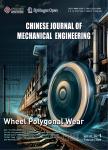Pressure Regulation for Earth Pressure Balance Control on Shield Tunneling Machine by Using Adaptive Robust Control
Pressure Regulation for Earth Pressure Balance Control on Shield Tunneling Machine by Using Adaptive Robust Control作者机构:State Key Laboratory of Fluid Power&Mechatronic SystemsZhejiang University.Hangzhou 310027.China
出 版 物:《Chinese Journal of Mechanical Engineering》 (中国机械工程学报(英文版))
年 卷 期:2016年第29卷第3期
页 面:598-606页
核心收录:
学科分类:081406[工学-桥梁与隧道工程] 08[工学] 0814[工学-土木工程] 082301[工学-道路与铁道工程] 0823[工学-交通运输工程]
基 金:Supported by National Natural Science Funds of China(Grant No.51275451) National Basic Research Program of China(973 Program,Grant No.2013CB035404) Science Fund for Creative Research Groups of National Natural Science Foundation of China(Grant No.51221004) National Hi-tech Research and Development Program of China(863 Program,Grant No.2013AA040203)
主 题:shield tunneling machine pressure regulation adaptive robust control
摘 要:Most current studies about shield tunneling machine focus on the construction safety and tunnel structure stability during the excavation. Behaviors of the machine itself are also studied, like some tracking control of the machine. Yet, few works concern about the hydraulic components, especially the pressure and flow rate regulation components. This research focuses on pressure control strategies by using proportional pressure relief valve, which is widely applied on typical shield tunneling machines. Modeling of a commercial pressure relief valve is done. The modeling centers on the main valve, because the dynamic performance is determined by the main valve. To validate such modeling, a frequency-experiment result of the pressure relief valve, whose bandwidth is about 3 Hz, is presented as comparison. The modeling and the frequency experimental result show that it is reasonable to regard the pressure relief valve as a second-order system with two low corner frequencies. PID control, dead band compensation control and adaptive robust control(ARC) are proposed and simulation results are presented. For the ARC, implements by using first order approximation and second order approximation are presented. The simulation results show that the second order approximation implement with ARC can track 4 Hz sine signal very well, and the two ARC simulation errors are within 0.2 MPa. Finally, experiment results of dead band compensation control and adaptive robust control are given. The results show that dead band compensation had about 30° phase lag and about 20% off of the amplitude attenuation. ARC is tracking with little phase lag and almost no amplitude attenuation. In this research, ARC has been tested on a pressure relief valve. It is able to improve the valve's dynamic performances greatly, and it is capable of the pressure control of shield machine excavation.



